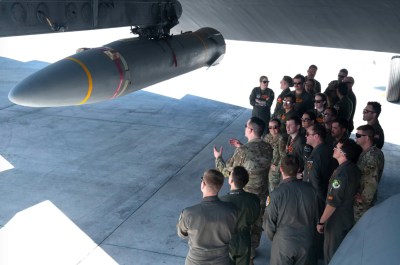In a striking reversal, the US Air Force’s recent display of a live Lockheed Martin AGM-183A Air-Launched Rapid Response Weapon (ARRW) hypersonic missile signals a potential comeback for the previously shelved high-stakes program.
This month, The War Zone reported that the US Air Force released pictures of a live AGM-183A ARRW hypersonic missile under the wing of a B-52H bomber during a training event at Andersen Air Force Base on Guam.
The pictures, which include two yellow bands on the front and rear indicating that it is a live weapon, raise new questions about the Air Force’s previously stated plans to kill the program.
“The AGM-183 ARRW is currently in the operational test phase of development. The Air Force has completed three of four planned test flights. A production decision has not yet been made,” an Air Force spokesperson told The War Zone.
The War Zone report describes the ARRW as an unpowered hypersonic boost-glide vehicle in the nose and a large rocket booster at the rear.
The weapon’s first full end-to-end test, which was conducted in December 2022, was deemed unsuccessful. The Warzone reports that the US Air Force has continued to carry out live-fire ARRW testing in the past year, with at least three more end-to-end tests taking place since March 2023.
The report notes that the US Air Force is also looking to conduct an ARRW operational demonstration despite its previously stated plans to close the program.

The War Zone report says that the US Air Force is now reconsidering the ARRW as a critical component of its plans. However, it notes that the high cost per missile, estimated between US$14.9-$17.5 million per unit, limits its use against high-value and heavily defended targets.
The US Air Force is actively pursuing new expeditionary and distributed operations concepts, with Guam central to planning around a possible kinetic fight in the Pacific against China.
As for the role of conventionally-armed hypersonic missiles such as the ARRW, US Air Force General Anthony Cotton, head of US Strategic Command (STRATCOM), recently re-emphasized the importance of conventional weapons in strategic-level operational planning, The War Zone reported.
More details on the US Air Force’s plans for ARRW testing are expected to emerge in the Pentagon’s budget request for the 2025 Fiscal Year, the report said.
Asia Times reported in April 2023 on the US Air Force’s previous decision to scrap the ARRW after a string of test failures. During a March 2023 test, the ARRW was successfully launched from a B-52H bomber off the coast of southern California, but the data link transmitting in-flight telemetry information failed.
That’s likely because the ARRW’s two-stage design is unnecessarily complicated, leading to more possible failure points and requiring more tests for design validation. Those design flaws may have been compounded by institutional problems within US hypersonic weapons testing procedures.
Despite those test failures, China’s improving anti-access/area denial (A2/AD) capabilities provide a strong impetus to develop a next-generation air-launched standoff weapon.
China’s A2/AD capabilities in the Pacific prevent theater access in a Taiwan or South China Sea contingency, threaten US and allied military bases and supply lines in the region and create a potent barrier around critical assets.
In response to China’s A2/AD strategy, the US Distributed Maritime Operations (DMO) concept is designed to counter adversaries like China with significant anti-ship capabilities. It aims to enhance US naval forces’ ability to counter A2/AD systems through resilient communication links, networking technologies and coordinating manned and unmanned vessels and aircraft.
In terms of implementation, the DMO concept requires the dispersion of forces, enhanced sensor and weapon distribution, and the use of longer-range weapons and unmanned systems.
Jon Lake says in a March 2021 Asian Military Review article that increasing the range of air-launched missiles is critical to defeating A2/AD threats in a maritime environment.
Lake mentions that as China’s A2/AD missiles, such as the DF-21D “carrier killer,” are difficult to shoot down once launched, destroying its launch platform before it reaches its firing location is preferable.
He notes that this has led to the development of longer-range defense systems, which, in turn, require faster and lower signature missiles to destroy.
Despite those challenges, Lake points out that A2/AD doesn’t establish an impenetrable area but changes the operational environment from “permissive” to “contested.” He says that although A2/AD doesn’t wholly stop attacking forces from operating in a specific location, it makes it risky and significantly restricts their movement.
Lake adds that the proliferation of A2/AD capabilities underscores the US’ need for standoff weapons such as the ARRW, with its long-range and hypersonic speed minimizing the launch platform’s vulnerability to enemy defenses.
The ARRW’s possible reintroduction may also align with US efforts to improve its air-based nuclear deterrent. While the US has not explicitly mentioned a nuclear role for its hypersonic missiles, the ARRW is a possible air-based delivery system for nuclear warheads.

In October 2023, Asia Times noted that the current US AGM-86B nuclear-tipped air-launched cruise missile (ALCM) has been upgraded to be operational until 2030, 38 years beyond its initial intended lifespan.
Improvements in China and Russia’s air defense capabilities, meanwhile, make penetrating their defended airspace prohibitive. America’s reliance on dated, subsonic nuclear delivery systems may reveal to adversaries that the US does not have a credible air-launched nuclear deterrent.
A next-generation air-launched hypersonic weapon would retain the long-serving B-52H’s nuclear capability and, at the same time, provide the upcoming B-21 Raider the means to hold heavily protected strategic targets at risk.

